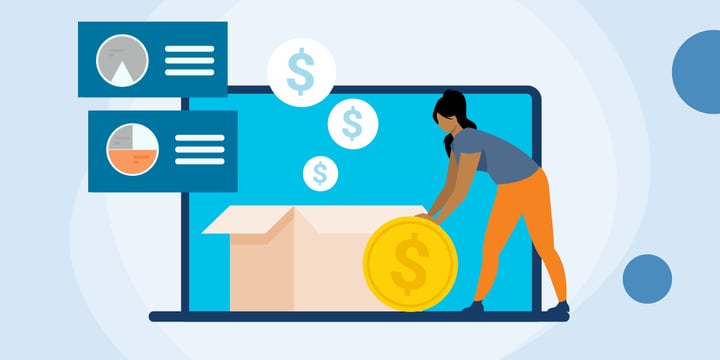The idea of data-driven nonprofits isn't new. You probably know that using data can help boost your fundraising. It can help deliver a better donor experience and give you deeper insights into your donors, ultimately helping you engage more supporters and inspire more donations.
But are you getting the most out of your data?

At Heller Consulting, we have worked with hundreds of organizations across the country, and we've seen this:
- How data can improve nonprofit fundraising efforts
- Examples of hits and misses when it comes to data-driven fundraising
- What you need to put data to work successfully for fundraising activities
Let's take a closer look at how to use data to boost your fundraising results.
How Data Can Improve Your Fundraising Efforts
The ability to analyze and apply data empowers nonprofit organizations to deliver a better donor experience. Today's donors are used to the consumer experience they get from for-profit companies. For example, think of how Netflix recommends a new show for you to watch. To engage constituents, organizations are expected to deliver that same kind of experience, including personalized fundraising asks. Having data at your fingertips allows you to better identify donor interests and customize campaigns to specific prospects.
Here are some considerations.
Personalization
Here's an example of how one nonprofit uses data to provide the types of experiences that donors and constituents expect.
Working with Heller Consulting, Humane Society of Silicon Valley (HSSV) mapped out various pet adoption path possibilities — including different types of pets, multiple pets, and returned pets — and how each adoption pathway and related data flow through their customer relationship management (CRM) technology ecosystem. Then, they set up automated, highly personalized email communications that
- Mention pets by name
- Provide tips appropriate for the type of pet
- Encourage deeper engagement with HSSV, including joining conversations on social media, volunteering, and making donations
Having accurate data in their CRM system allows the HSSV staff to better understand their donors and create more impactful fundraising campaigns based on how their donors and adopters have engaged with the organization.
Tracking Donor Interests
Using your donor and constituent data, you can employ marketing automation to track donors based on specified criteria and easily see the interests of individual donors. This allows you to identify the best prospects for specific campaigns rather than emailing your entire list about every campaign. Sending emails to the best prospects can have a positive impact on your fundraising. In fact, one of our clients was able to double their fundraising revenue by segmenting their email lists and sending fewer, more targeted emails.
Moving Donors up the Fundraising Pyramid
Using your data, you can also streamline the process of moving donors up the fundraising pyramid by identifying trends. A common example is identifying people who have donated more than once in a four-to-six-month period or more than three times in a year and taking them through a targeted email campaign. The campaign can start by giving them more information about the impact of their donations, then asking them more about their interests, and finally sending a personalized request to become a sustaining — or monthly — donor.
These are just some of many ways to use data to drive better fundraising results. Data can be used for everything from stewarding mid-level donors to analyzing donor lifetime value.
A Hit and a Miss with Data-Driven Fundraising
Now let's take a look at what works and what doesn't when it comes to data-driven fundraising. Here are two real-world data-driven appeals — one that worked well and one that worked not so well.
The Hit
I recently received a direct mail piece from a university I attended. I've made a modest annual gift to them over the last 10 years. This appeal included a thank-you message and a sticker. The piece of mail was a "win" because it clearly used the data I've provided by acknowledging my name and giving history. It made me feel good as a donor. I felt more connected to the university and inspired to continue giving.
The Miss
I received another appeal from a global humanitarian NGO that I gave to throughout the year. It was an email asking for an end-of-year gift. This was a miss because, even though it was personalized with my name and previous gift information, the information was inaccurate. I was confused, and after sorting through my email, I found the confirmation message that showed I had already made my end-of-year gift. The extra time and confusion didn't leave me with a great feeling as a donor.
Put Data to Work for Your Fundraising Activities
The last thing you want to do is confuse donors, but where can you focus your efforts for maximum payoff? The right set of tools to collect, store, track, analyze, and use data will help you automate processes and free up your staff to focus on the data itself and the strategy around how to use the data. The centerpiece of those tools is a CRM or donor database system.
No single combination of tools will be right for every nonprofit because every nonprofit's needs and goals are unique. But no matter what your CRM technology ecosystem looks like, it needs to support three key aspects of your data: accuracy, timeliness, and integration.
Accuracy
The "miss" appeal didn't work because the information included in the appeal wasn't accurate. It didn't match up with my giving history, which left me with a poor donor experience. This can be mitigated by having a robust CRM system in place that gives you a clear picture of your donors. There are several options out there that allow you to sync with financial data in real time and show you when a donor last contributed and how much they donated. One of the most common appeals our clients use is, "Thanks for donating x amount last month! Can you increase that by $1 this month?" It's a simple ask, but it requires the amount listed to be accurate.
Timeliness
In the "miss" appeal, it's possible that the organization's syncs between systems didn't happen in a timely manner. If the correct information didn't make it back into their CRM system fast enough, they might have lacked the latest information when they did the audience segmentation for the appeal. To avoid this, be sure to double-check that syncs are working between your organization's finance records and your CRM system, and then check that your CRM system and marketing tools are syncing correctly. Many Heller Consulting clients bake this double-check into their to-do lists before sending a fundraising campaign.
Integration
Both accuracy and timeliness of data are ideal, and they are closely tied with basic integration. If systems aren't integrated, or talking to each other properly, it can be very difficult to know if the data in the central CRM system is truly the latest, most accurate data.
Learn More About Data-Driven Fundraising
Using data to boost your fundraising requires a combination of the right data, strategy, and tools. Having these components in place will give your organization the power to evaluate your fundraising campaigns, identify donor trends, and use accurate information to make more personalized asks. These activities ultimately lead to a better donor experience, making donors feel more connected to your cause and more inspired to give.
Find out more about the strategies, tools, and techniques that can help you power up your fundraising by watching Power Fundraising with CRM, a webinar from Heller Consulting.
You can also check more fundraising resources from the TechSoup catalog, which is full of helpful digital tools to take your fundraising to the next level.
About the Author
Jett Winders works collaboratively with nonprofits to map their business needs to CRM tools so that they can deliver their missions more effectively and raise money more efficiently. Heller Consulting has been focused on helping nonprofits with their CRM technology since 1996. After working with over 1,000 nonprofits around the country, one thing hasn't changed — our passion for helping clients utilize the right technology strategies and systems to significantly expand the impact of their vital missions.
Additional Resources
- Check out TechSoup Courses' Nonprofit Data and Impact Measurement Mega-Pack.
- More from TechSoup Courses: Fundraising for Nonprofits.
- Read about Budgeting for CRM: 4 Steps to Finding the Right System for Your Nonprofit.
- Watch the webinar M+R Benchmarks 2020 — A Data Odyssey.








